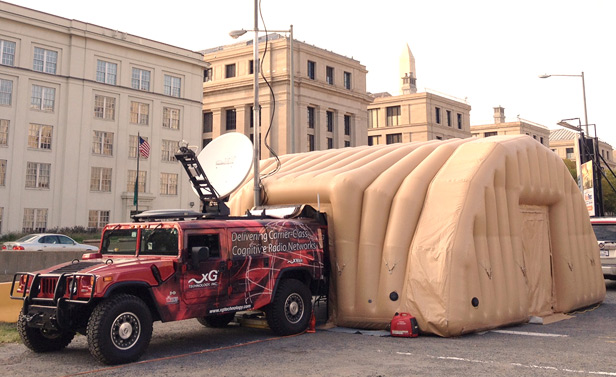4G on the Baby-Monitor Frequency

Early next year in a swath of northern Florida, as many as 8,000 people will be able to get 4G wireless broadband with a twist: the service will beam over a frequency normally used by gadgets like garage-door openers and baby monitors.
The project at Northeast Florida Telephone, using gear from a startup called XG Technology of Sarasota, Florida, appears to be the first commercial use of cognitive radio, which senses available frequencies and switches between them on the fly. Cognitive radios are now used mainly by the military.
The technology is one of many creative approaches that will be needed to forestall a spectrum shortage triggered by the boom in super-fast smartphones. U.S. mobile data traffic quadrupled last year.
Other companies are filling gaps with something called “super Wi-Fi,” tapping unused parts of the TV spectrum (also often called white spaces) to deliver service. But those frequencies become available only with advance notice, not on an instant, real-time basis.
The $2.4 million Florida project is different. When it is running, the service will send and receive signals over the 902 to 928 megahertz band—the usual domain of cordless phones, baby monitors, garage-door openers, and similar short-range devices. (Normally, in the United States, cell-phone service is delivered in the 800 megahertz and 1,900 megahertz bands.) Then, using an approach called dynamic spectrum access, the technology divides that range into 18 channels, and uses real-time sensing to detect sudden interference—triggered by someone else using the channel to, say, open the garage—and switch channels within 20 milliseconds. The service should deliver data at six megabits per second, about four times faster than DSL service.
The service provider will install about 130 bread-box sized transmitters on rooftops and light poles in the area, and then give each subscriber a device the size of a deck of cards. The subscriber could use that converter box at home or while mobile. In the future, such a converter could be miniaturized and included within smartphones.
Despite the drawback of having to tote around the converter for now, people in Baker County, Florida, “will have, for the first time, access to pretty good broadband speeds at low prices, and they’ll have it for fixed and mobile, and access to mobile voice at very competitive prices,” says Ben Dickens, counsel to Northeast Florida Telephone. (Dickens says he doesn’t yet know what the monthly pricing will be.)
Craig Partridge, chief scientist for networking research at Raytheon BBN Technologies in Cambridge, Massachusetts, says the Florida deal will mark the first commercial use of cognitive radios and will highlight the fact that the technology has “an important role to play in the commercial sector.”
The Florida carrier is one of about 1,300 U.S. carriers serving rural areas that may never get full coverage from giants like AT&T and Verizon. The FCC is subsidizing myriad efforts to fill these gaps. Last week, for example, it announced $300 million in grants to bring mobile broadband to rural areas that include 83,000 miles of roadway (see “635,392 U.S. Road Miles Lack 3G or 4G.”)
Other companies are making advanced cognitive radios and research platforms, including Cognitive Radio Technologies, a startup out of Virginia Tech, and Radio Technology Systems of Ocean Grove, New Jersey (see “Frequency Hopping Radio Wastes Less Spectrum”). The latter company’s research platform, called CogRadio, stretches the approach to new limits. It’s able to sense available spectrum and switch between frequencies anywhere from 100 megahertz to 7.5 gigahertz.
Such a radio, if it ever became cheap enough, could ultimately make optimal use of any spectrum all the way from AM and FM bands though television and Wi-Fi and cellular frequencies—even delivering unbroken audio and video streams that might at any given moment be using any piece of that spectrum.
Such technologies will increasingly be needed. A White House report, coauthored by industry leaders including Google chairman Eric Schmidt, earlier this year urged the industry to develop intelligent spectrum-sharing technologies.
And last week in a speech, FCC chairman Julius Genachowski reiterated that “spectrum is finite, at least with current and foreseeable technologies. Just as we must pursue future-oriented energy technologies and policies, we have no choice on our airwaves: we must make better, more efficient use of spectrum.” He added: “The sobering fact is that based on today’s projections and today’s technologies, demand threatens to outpace the supply of spectrum available for mobile broadband in the coming years.”
Keep Reading
Most Popular
Large language models can do jaw-dropping things. But nobody knows exactly why.
And that's a problem. Figuring it out is one of the biggest scientific puzzles of our time and a crucial step towards controlling more powerful future models.
How scientists traced a mysterious covid case back to six toilets
When wastewater surveillance turns into a hunt for a single infected individual, the ethics get tricky.
The problem with plug-in hybrids? Their drivers.
Plug-in hybrids are often sold as a transition to EVs, but new data from Europe shows we’re still underestimating the emissions they produce.
Google DeepMind’s new generative model makes Super Mario–like games from scratch
Genie learns how to control games by watching hours and hours of video. It could help train next-gen robots too.
Stay connected
Get the latest updates from
MIT Technology Review
Discover special offers, top stories, upcoming events, and more.